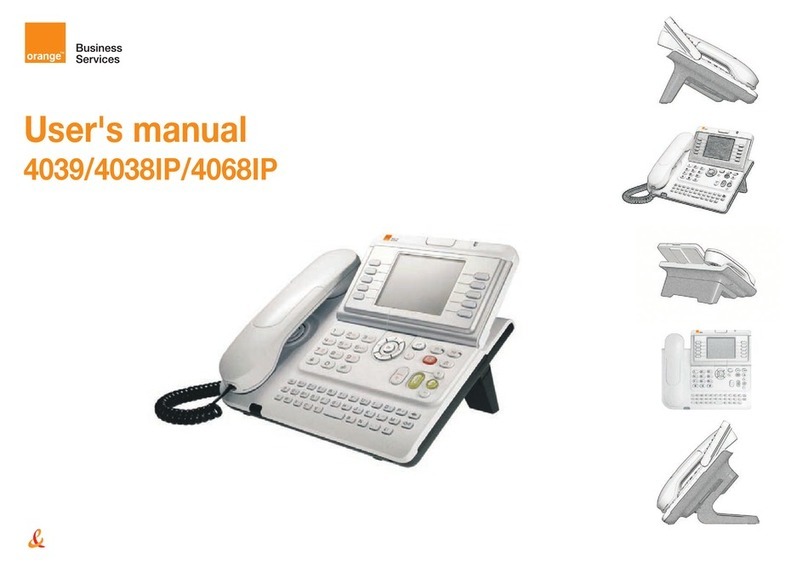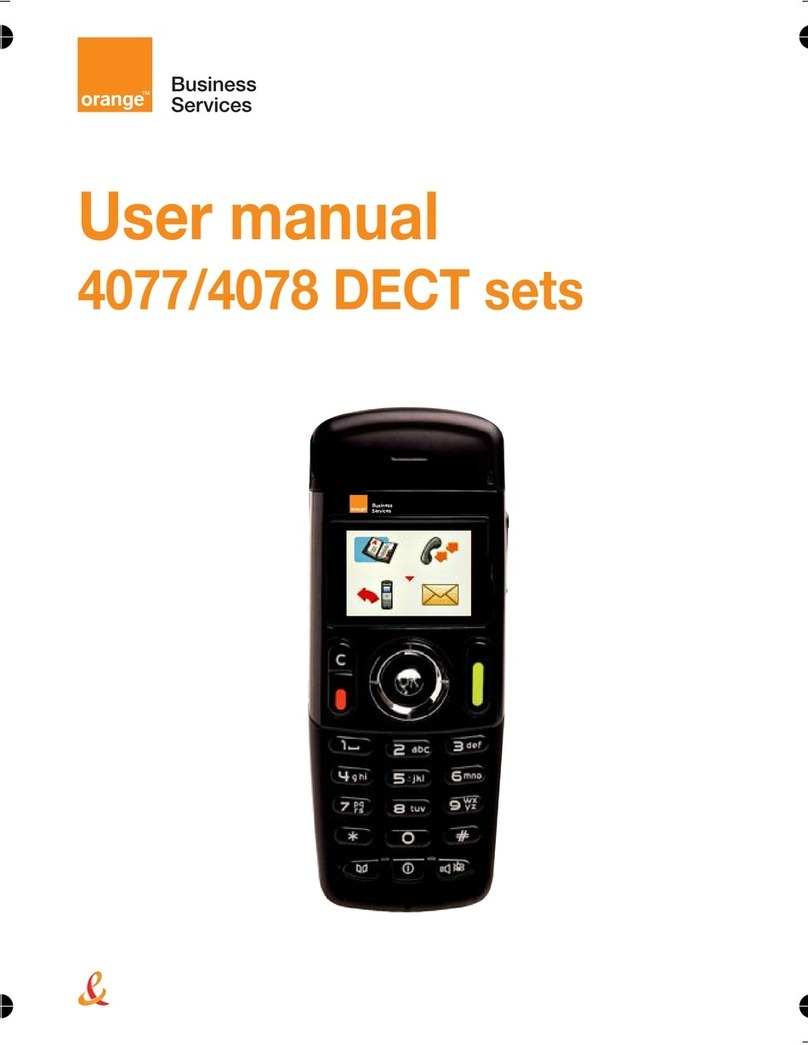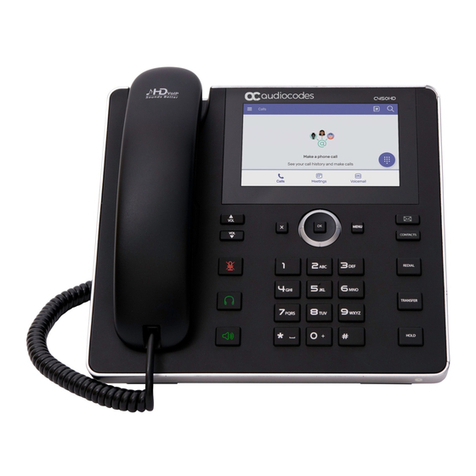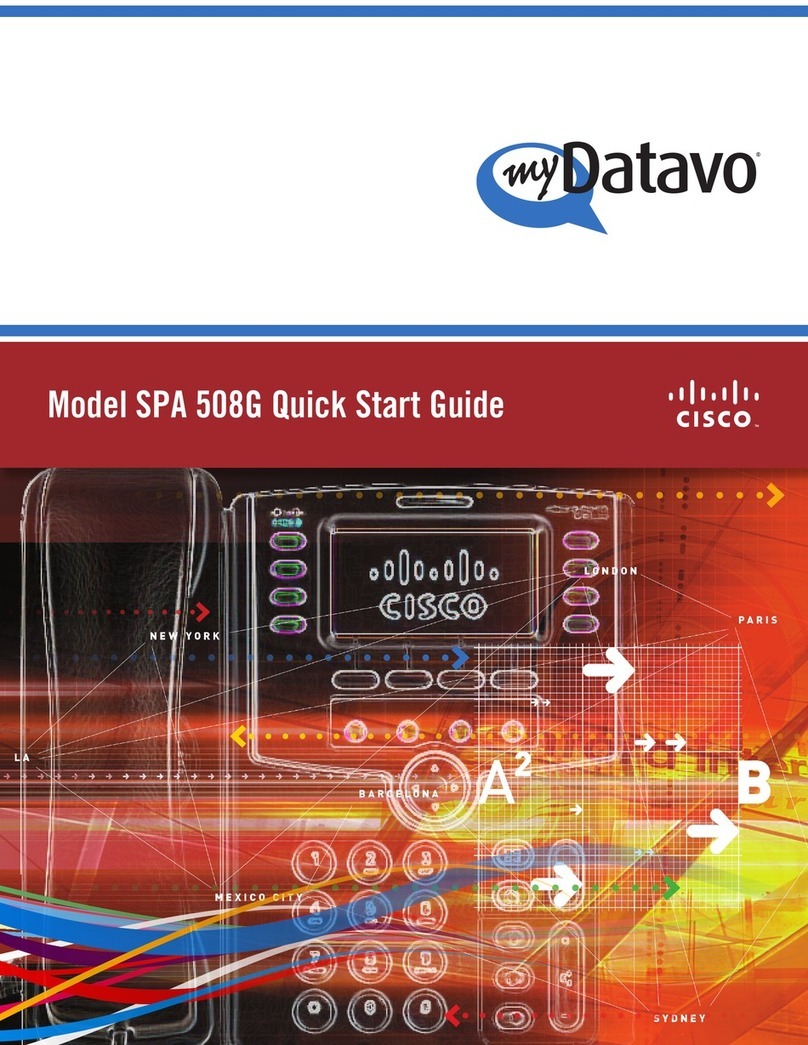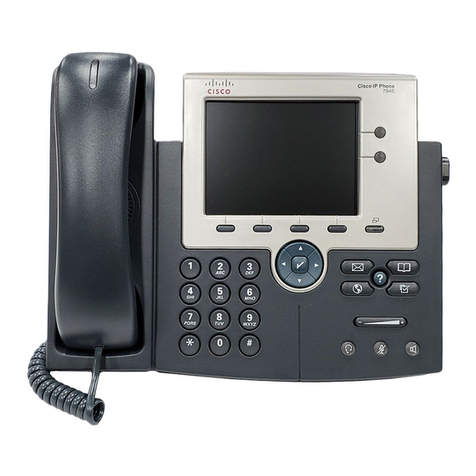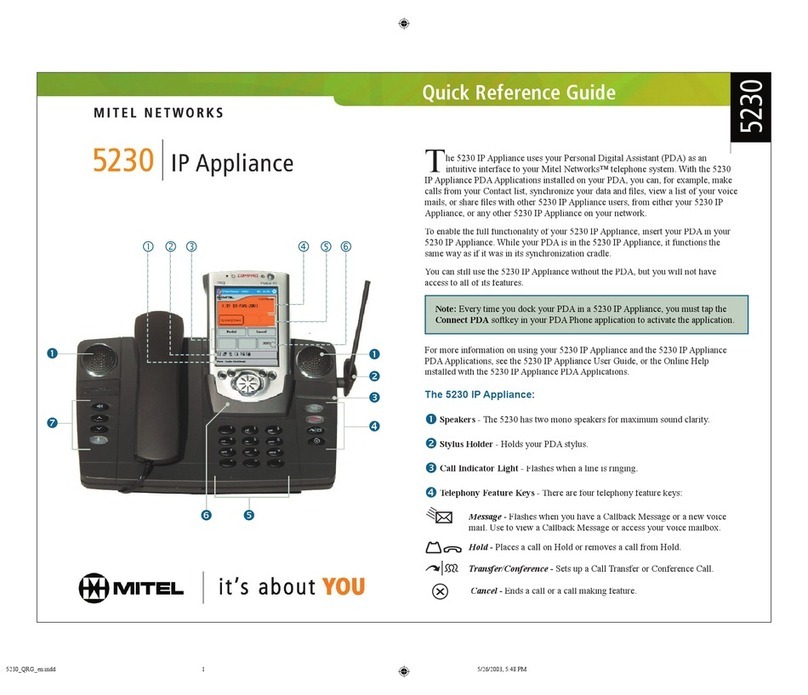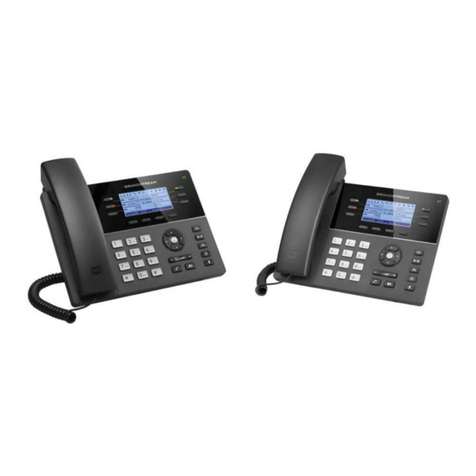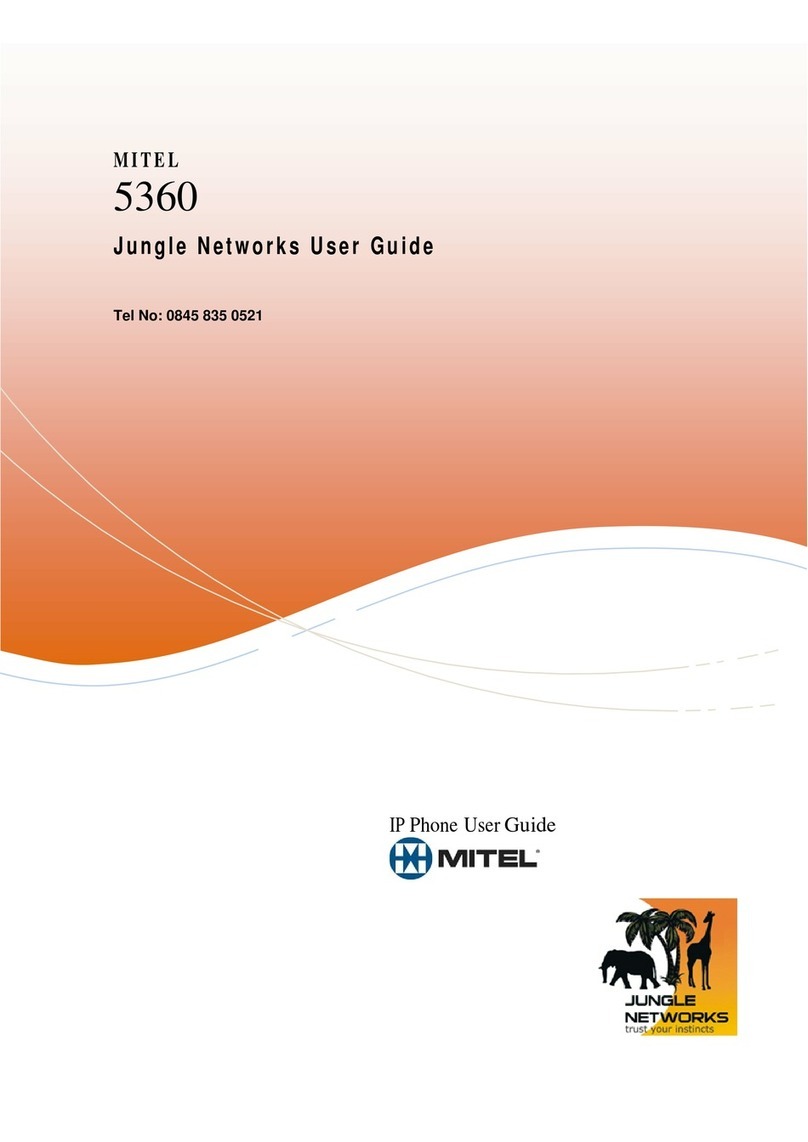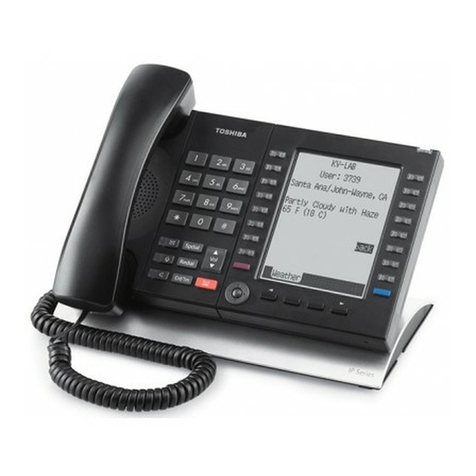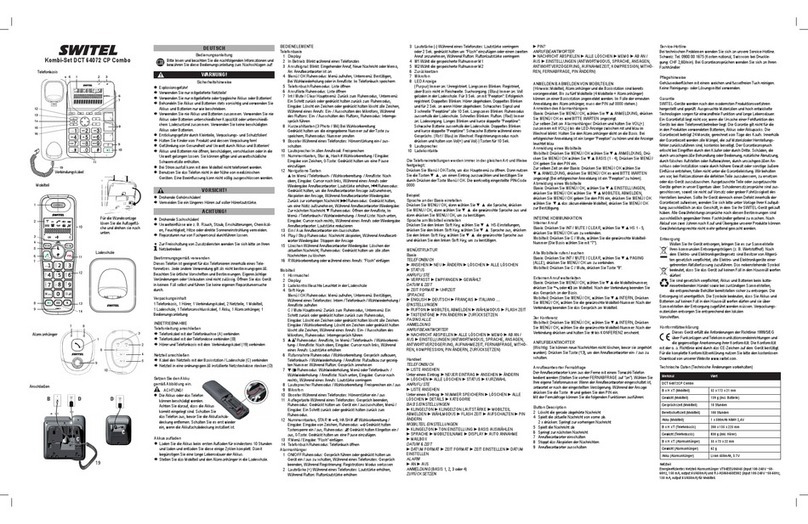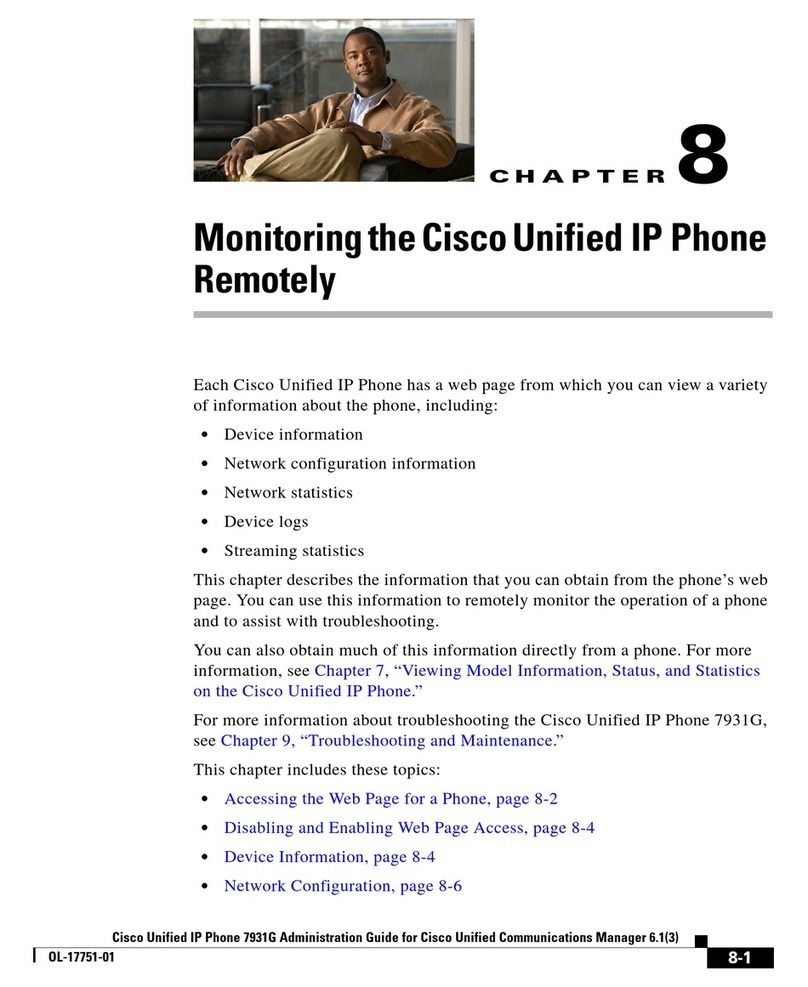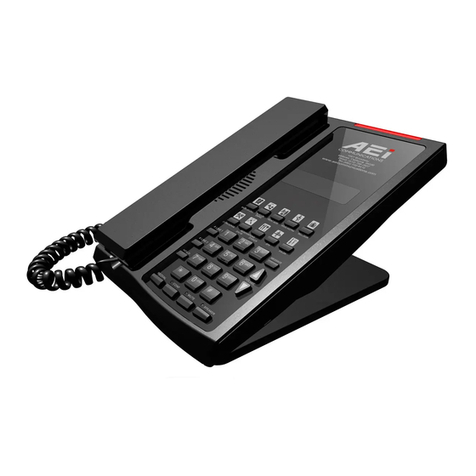ORANGE 4039 User manual

Operator terminal
User's manual

2
User manual
how
This guide describes the services offered by the 4039/4038IP/4068IP operator station (OS) connected to an e-
Diatonis system.
This guide covers the specific functions of the operator station (consult the station user manual for a decsription of
the other services):
restricted service,
reserving a group of outside lines for exclusive operator use,
diverting operator calls to another number,
broadcasting background music on the external loudspeaker,
answering a night call,
programming.
The operator station receives incoming calls and routes them to the appropriate extensions within the system.
Depending on the amount of traffic handled, your system can have one or more operator stations:
grouped: all stations ring simultaneously,
assigned to specific time periods: only stations currently operational will ring.
This option is set up by your installation technician.
How to use this guide
These symbols can be supplemented by small icons or text.
•Actions •Keypad
Lift the receiver. Numeric keypad.
Hang up. Alphabetic keypad.
Specific key on numeric keypad.
•Navigator
Move the navigation key up, down, to the left or to the right.
To go back one level (press and release) or to return to the welcome page (press and
hold) ; during a conversation, can be used to access the different pages (Menu, Perso,
etc.) and to return to the telephone screens.
•Display and display keys •Audio keys
Partial view of display. Loudspeaker,
hands free.
Display key. Adjustment “reduce”.
Adjustment “increase”.
•Programmable keys and icons •Other fixed keys
Line key. Fixed key.
Icon corresponding to key. MENU key.
Voice mail access key.
•Other symbols used
Means that the function is accessible from the Menu page.
Means that the function is accessible from the Perso page.
Means that the function is accessible from the Info page.
2
6
5
3
abc
def
jkl
mno
2
Smith John
…

3
Contents
Toc
Getting to know your telephone . . . . . . . . . . . . . . . . . . . . . . . . . . . . . . . . . . . . . . p. 4
1. Operator station (OS) functions. . . . . . . . . . . . . . . . . . . . . . . . . . . . . . . . . . . . . . . p. 5
1.1 Setting restricted service . . . . . . . . . . . . . . . . . . . . . . . . . . . . . . . . . . . . . . . . . . . . . . . . . . p. 5
1.2 Reserving a group of lines. . . . . . . . . . . . . . . . . . . . . . . . . . . . . . . . . . . . . . . . . . . . . . . . . . p. 5
1.3 Manually diverting operator calls to another number . . . . . . . . . . . . . . . . . . . . . . . . . . . . . p. 5
1.4 Broadcasting background music on the external loudspeaker . . . . . . . . . . . . . . . . . . . . . p. 5
1.5 Answering a night call . . . . . . . . . . . . . . . . . . . . . . . . . . . . . . . . . . . . . . . . . . . . . . . . . . . . . p. 5
1.6 Using a headset . . . . . . . . . . . . . . . . . . . . . . . . . . . . . . . . . . . . . . . . . . . . . . . . . . . . . . . . . p. 6
1.7 When you return, consult your general voice mailbox . . . . . . . . . . . . . . . . . . . . . . . . . . . . p. 6
2. Programming functions;. . . . . . . . . . . . . . . . . . . . . . . . . . . . . . . . . . . . . . . . . . . . . p. 7
2.1 Accessing programming . . . . . . . . . . . . . . . . . . . . . . . . . . . . . . . . . . . . . . . . . . . . . . . . . . . p. 7
2.2 Programming system directory (ComSpD) . . . . . . . . . . . . . . . . . . . . . . . . . . . . . . . . . . . . . p. 7
2.3 Programming date and time (Clock) . . . . . . . . . . . . . . . . . . . . . . . . . . . . . . . . . . . . . . . . . . p. 7
3. Setting various subscriber telephone parameters . . . . . . . . . . . . . . . . . . . . . . . p. 8
3.1 Accessing the subscriber function . . . . . . . . . . . . . . . . . . . . . . . . . . . . . . . . . . . . . . . . . . . p. 8
3.2 Subscriber name (Name). . . . . . . . . . . . . . . . . . . . . . . . . . . . . . . . . . . . . . . . . . . . . . . . . . . p. 8
3.3 Resetting a subscriber password (ResCod) . . . . . . . . . . . . . . . . . . . . . . . . . . . . . . . . . . . . p. 8
3.4 Subscriber display language (Lang) . . . . . . . . . . . . . . . . . . . . . . . . . . . . . . . . . . . . . . . . . . p. 8
3.5 Subscriber personal directory (PerSPD) . . . . . . . . . . . . . . . . . . . . . . . . . . . . . . . . . . . . . . . p. 8
3.6 Subscriber discrimination criteria (Barring) . . . . . . . . . . . . . . . . . . . . . . . . . . . . . . . . . . . . . p. 8
3.7 Enable the CLASS service . . . . . . . . . . . . . . . . . . . . . . . . . . . . . . . . . . . . . . . . . . . . . . . . . p. 8
4.
4.1 Accessing the "Expert" function . . . . . . . . . . . . . . . . . . . . . . . . . . . . . . . . . . . . . . . . . . . . . p. 9
4.2 Table of business codes (Accoun) . . . . . . . . . . . . . . . . . . . . . . . . . . . . . . . . . . . . . . . . . . . p. 9
4.3 Direct numbers of extensions (PubNum) . . . . . . . . . . . . . . . . . . . . . . . . . . . . . . . . . . . . . . p. 9
4.4 Greeting and holding messages (MOH) . . . . . . . . . . . . . . . . . . . . . . . . . . . . . . . . . . . . . . . p. 10
4.5 DECT cordless telephones . . . . . . . . . . . . . . . . . . . . . . . . . . . . . . . . . . . . . . . . . . . . . . . . . p. 10
4.6 Changing the operator password (Passwd) . . . . . . . . . . . . . . . . . . . . . . . . . . . . . . . . . . . . p. 11
4.7 Resetting the system (RstSys) . . . . . . . . . . . . . . . . . . . . . . . . . . . . . . . . . . . . . . . . . . . . . . p. 11
4.8 Voice message service . . . . . . . . . . . . . . . . . . . . . . . . . . . . . . . . . . . . . . . . . . . . . . . . . . . . p. 11
4.9 Software licence agreements . . . . . . . . . . . . . . . . . . . . . . . . . . . . . . . . . . . . . . . . . . . . . . . p. 12
Declaration of conformity . . . . . . . . . . . . . . . . . . . . . . . . . . . . . . . . . . . . . . . . . . . p. 13
Complementary 'Expert' functions . . . . . . . . . . . . . . . . . . . . . . . . . . . . . . . . . . . . .p. 9

Getting to know your telephone
4
4068IP
Handset
Socket for connecting headphones or a
Hands-free / Loudspeaker unit
Audio keys
Hang-up key:
to terminate a call.
Hands-free/Loudspeaker Key:
to make or answer a call without lifting the receiver.
•Lit in hands-free mode or headset mode (short press).
•Flashing in loudspeaker mode (long press).
Intercom/Mute key:
•During a conversation: press this key so that your correspondent can no longer hear
you.
•Terminal idle: press this key to answer calls automatically without picking up the
receiver.
To adjust the loudspeaker or handset volume up or down
Extension unit
An extension unit can be fitted to your telephone. This provides addi-
tional keys which can be configured as function keys, line keys, call
keys etc.
To affix labels:
push the holding strip of the unit backwards to you and
lift it. Install the label under the keypad, in the housing designed for,
and place the keypad back into position.
Three-colour indicator light
The indicator light on your terminal enables you to monitor the system. The light has five possible statuses (colours and/or flashing):
Flashing green
: message received (voice or screen) or call received in the “ calls received ” memory.
Orange fixed
: indicates traffic overload level 1 (1 is calls on hold).
Flashing orange
: terminal on test.;
Red fixed
: indicates traffic overload level 2 (call unanswered within 20 seconds or number of calls on hold exceeds number of operator
stations).
Flashing red
: several low priority system messages present or one very serious system message indicating a system hardware fault.
Alphabetic keypad
Display and display keys
Contains several lines and pages providing information on calls and the functions accessible via the 10 keys associated with the words
on the screen.
Transfer icon:
pressing the key next to this icon allows you to program or change the transfer function.
Headset connected. Appointment programmed.
Silent mode activated. Telephone locked.
Display keys:
pressing a display key activates the function shown associated with it on the screen.
Navigation
OK key:
used to validate your choices and options while programming or configuring.
Left-right navigator:
used to move from one page to another.
Up-down navigator:
used to scroll through the content of a page.
Back/Exit key:
to return to previous menu (short press) or return to first screen (long press) ; during a conversation, pro-
vides access to welcome screens (Menu, Info, ...) and to return to the conversation icon screens.
Call display
Incoming call. Call in progress or outgoing call.
Call on hold*.
If you get two calls at the same time, you can switch from one call to the
other by pressing the display key associated with each call.
Left-right navigator:
used to check calls.
Function keys and programmable keys
Guide key:
used to obtain information on functions of the 'menu' page and to program key of the 'perso' page.
Messaging key to access various mail services:
if the key flashes, a new voice message or a new text message has been received.
'Redial' key:
to access the 'Redial' function.
Programmable key (F1 and F2 keys):
lit when the function associated with the key is activated.
Some other keys have been programmed by your technician for your own convenience:
Key must be programmed by your technician to access a service.
Adjust the tilt of the screen

5
Operator station (OS) functions
1
Other
1.1 Setting restricted service
This function sets the system to restricted service.
All incoming calls are directed to a general ring or a programmed number:
1.2 Reserving a group of lines
For maximum availability of the operator station, thus assuring optimum reception of incoming calls, a group of outside
lines can be reserved which will only be available to the operator station(s):
display and tone indicate service
active
access the 'Perso'
page
operator password
(by default
HELP1954 )
key icon indicates service
active
To restore normal service, repeat operation.
If an outside number has been entered by the installation technician, selection of
restricted service will automatically divert calls received by the operator to the
defined outside number.
PERSO
10:30
Night
2
6
5
3
abc
def
jkl
mn
o
display and tone indicate
service active
“Reserved TGp”
programmed key
operator password
(by default
HELP1954 )
key icon indicates service
active
To cancel the line reservation, repeat operation.
1.3 Manually diverting operator calls to another number
During a period of absence, the operator can divert all calls received (incoming calls and internals calls
dialling 9) to another number:
1.4 Broadcasting background music on the external loudspeaker
1.5 Answering a night call
An incoming night call is indicated in the same way as an ordinary call:
•Opening the door:
reach the 'Menu'
page
enter the number of the
terminal to receive the
message
operator password
(by default
HELP1954 )
key icon indicates service
active
menu
10:30
AttDiv
2
6
5
3
abc
def
jkl
mn
o
2
6
5
3
abc
def
jkl
mno
OR
Rediallist
OR
Indiv.rep.
display and tone indicate
service active;
reach the 'Menu'
page
operator password
(by default
HELP1954 )
key icon indicates service
active
menu
10:30
Music
2
6
5
3
abc
def
jkl
mn
o
your telephone
rings
the night call name or n°is
displayed
lift the receiver hands free
'Unlock Door' programmed key or
function code
OR
OR
2
6
5
3
abc
def
jkl
mn
o

Operator station (OS) functions
6
1.6 Using a headset
You can connect a headset instead of your receiver.
•To activate or deactivate headset mode:
•Answering or making a call:
•To activate or deactivate the loudspeaker during a conversation:
To answer in intercom mode:
reach the 'Menu'
page
activating/deactivating
'forced headset' mode
Function active
hands free
during a conversation Function active
corresponding LED
lights up cancel intercom mode
menu
10:30
Settings
Phone
ForcedHead
On
OR
Off
1.7 When you return, consult your general voice mailbox
The light indicates that messages have been received
display number of new and
old messages
operator
password
(by default
HELP1954 )
display name of sender, with date, time and
ranking of message
select message
listen to message erase message
Genmailbox
2
6
5
3
abc
def
jkl
mn
o
Consult
Play
OR
Clear

7
Programming functions
2
Other
2.1 Accessing programming
Your e-Diatonis system's operator station can access the general programming services.
2.2 Programming system directory (ComSpD)
This function can be used to programme system short numbers, accessible to all system users:
•To enter another short number:
access programming
function
access the 'Perso'
page
operator password
(by default
HELP1954 )
menu
10:30
Operator
2
6
5
3
abc
def
jkl
mn
o
display gives first short
number
reach the 'Menu'
page
enter name
(max. 16 charact
ers)
enter the first
name
programmed short
number is displayed
enter number
(max. 21 digits)
to select another
short number
menu
10:30
Speeddial
Modify
2
6
5
3
abc
def
jkl
mn
o
OR
New
2.3 Programming date and time (Clock)
•Changing date and time:
in programming function
enter date
and time
previous
character
next character
Clock
2
6
5
3
abc
def
jkl
mn
o
OR
OR
Clear

8
Setting various subscriber telephone parameters
3
Other
3.1 Accessing the subscriber function
This function provides access to the various parameters defined for a system user or subscriber,
identified by an extension number:
3.2 Subscriber name (Name)
•Changing the name:
3.3 Resetting a subscriber password (ResCod)
This function is used to cancel a subscriber password and restore the default password (1515):
3.4 Subscriber display language (Lang)
This function is used to specificy the display language for the selected subscriber.
Pressing this key scrolls the various languages available:
access to
“Subscriber”
programming function
reach the 'Menu'
page
enter extension n°to
be programmed
menu
10:30
Subscriber
2
6
5
3
abc
def
jkl
mno
in “Subscriber”
function
enter name
previous
character
next character
Name
OR
OR
Clear
in “Subscriber” function
Pwdreset
OR
OK
in “Subscriber” function
select the language of your
choice (consecutive presses)
Language
Choice
3.5 Subscriber personal directory (PerSPD)
This function is used to create the personal directory of the selected subscriber:
•Changing a name or number:
3.6 Subscriber discrimination criteria (Barring)
This function is used to define discrimination criteria for each subscriber:
3.7 Enable the CLASS service
Enabling the CLASS service is used to display information (caller name, number, etc.) on the display of an analogue
set.
in “Subscriber” function
display gives first number
enter name (max.
6 characters)
enter public number
(max. 19 digits)
previous
character
next character
Indiv.rep.
Modify
2
6
5
3
abc
def
jkl
mn
o
OR
OR
Clear
in “Subscriber”
function
selection displayed on first
line
selection of
discrimination
criteria
This function is used to describe discrimination criteria for each subscriber.
Barring
Modify
in “Subscriber”
function
select the “CLASS”
service
apply
the CLASS service is selected when the 'CLASS' label is displayed on the screen.
Terminal
Class

9
4
Other
4.1 Accessing the 'Expert' function
4.2 Table of business codes (Accoun)
This function is used to define the table of business codes enabling a subscriber to charge his/her calls to a business
account:
•On 'Param1'
access to “Expert”
programming function
reach the 'Menu'
page
menu
10:30
Expert
in “Expert” function
create an entry
max. 16 digits max. 16 characters
indicate whether identity
required or not
indicate whether password
required or not
Accoun
Add
Code
OR
Name
OR
Param1
OR
Param2
UserID
OR
Protected
•On 'Param2'
4.3 Direct numbers of extensions (PubNum)
This function is used to define the table of direct numbers (SDA) of extensions (PubNum).
•Modifying an entry:
indicate discrimination
category
indicate number of masked
digits
“'Barrng': discrimination category: none, 1 to 16, that of subscriber (SET) or that of
user (GUEST).
'Barrin' : number of digits : DEF (default value : 4), all, none, 1 to 9.
Barring
OR
Mask
in “Expert” function
create an entry
direct n°or n°
forming prefix
number of extensions
within assigned range
(max. 99)
public n°of first
extension
go to previous
entry
go to next entry
select specific entry modify contents of entry
displayed
PublicNr
New
2
6
5
3
abc
def
jkl
mn
o
2
6
5
3
abc
def
jkl
mn
o
2
6
5
3
abc
def
jkl
mn
o
OR
OR
Clear
OR
Goto
Modify
Complementary 'Expert' functions

10
4.4 Greeting and holding messages (MOH)
This function is used to define the greeting message and hold music parameters.
To record a message:
in “Expert” function
This function is used to record 8 greeting messages
or holding music.
listen to the recorded /
default message
record a message
erase the recorded message and replace it with the default message
display invites you to start
recording
record message to stop stop recording momentarily
duration of message is displayed
Hold music may be subject to author's rights and appropriate action should be taken
in this respect.
This function is used to select a music source (3 possible
sources).
by default personal outside
Voice
Holdmusic
OR
Musicsource
OR
ACD
Holdmusic
Holdmusic
Listen
OR
Record
OR
Default
Yes OR
No
Record
Record
OR
Stop
OR
Pause
Musicsource
Default
OR
Customized
OR
External
4.5 DECT cordless telephones
This function is used to manage DECT telephones and to create DECT GAP extensions.
•Adding a DECT GAP extension:
Used to record, for each ACD group, welcome, please
wait, dissuasion, closed or estimated waiting time
messages.
select the ACD
group
select the type of
message to record
start the recording to apply
OK
ACD
Record
Record
OR
Stop
OR
Pause
in “Expert” function
DECT GAP
extension is
created
public network n°of DECT
extension
waiting for creation from DECT GAP
extension
follow instructions given on
display
at end of creation
DECT
Add
In progress
...
2
6
5
3
abc
def
jkl
mn
o
Modify
Complementary 'Expert' functions

Complementary 'Expert' functions
11
4.6 Changing the operator password (Passwd)
This function is used to change the operator session password:
4.7 Resetting the system (RstSys)
This function is used for a hot or cold system reset:
4.8 Voice message service
This function is used to manage the voice guides and to configure the broadcasting lists.
in “Expert” function display asks for old
password
display asks for new
password
enter the old
password
(8 alphanumerical
characters)
enter the new password
(8 alphanumerical
characters)
display requests
confirmation of new
password
enter new
password again
to confirm
Password
2
6
5
3
abc
def
jkl
mn
o
2
6
5
3
abc
def
jkl
mn
o
2
6
5
3
abc
def
jkl
mn
o
in “Expert” function
Acold reset will restore your system default configuration (our specific configuration
will be lost). The reset request must be confirmed.
Systemreset
Cold
OR
Warm
Yes
OR
No
in “Expert” function
VMail
Autoattend.
OR
Audiotext
OR
List
OR
Genmailbox
OR
Infomessage
OR
Notification
You can:
listen to the voice guide (default or personalized)
record a personalized voice guide
erase the personalized voice guide and replace it with the default voice guide.
You can:
listen to the voice guide (default or personalized)
record a personalized voice guide
erase the personalized voice guide and replace it with the default voice guide.
Configuration of 3 types of voice guides for the
automatic switchboard (day, night, 'Good-bye')
message.
opening times voice guides closing times voice guides 'Goodbye' voice guides
Configuration of 3 types of Audiotex (day, night, 'Good-bye' message)
opening times Audiotex closing times Audiotex 'Goodbye' Audiotex
Autoattend.
Autoattend.
Day
OR
Night
OR
Goodbye
Audiotext
Audiotext
Day
OR
Night
OR
Goodbye
record of the MLAA vocal messages (Multi-Language
Automated Attendant)
select the language for the
messages to record (1 to 4)
select the message to
record (1 to 100)
enter directly the number
of the message to record
MLAA
MLAA
OR
Goto
OR
MLAA

Complementary 'Expert' functions
12
Defining the general mailbox greeting message
listen to the recorded /
default message record a message
erase the recorded message and replace it with the default message
Recording of information messages used by the PABX and
the Audiotex service (opening or closing times); maximum of
50 messages.
listen to the recorded
message
record a message
previous message go to next
message
Defining the message notification announcement
listen to recorded /
default announcement
record a personalized
announcement
erase the recorded announcement and replace it with the default announcement
Genmailbox
Genmailbox
Listen
OR
Record
OR
Default
Yes
OR
No
Infomessage
Infomessage
Listen
OR
Record
OR
OR
Notification
Notification
Listen
OR
Record
OR
Default
Yes
OR
No
4.9 Software licence agreements
This function is used to read or modify the software licence agreements.
Reading the system software licence agreement.
Configuration of the CTI software licence agreement.
in “Expert” function
Softw.keys
Main
OR
CTI
Softw.keys
CTI
Personalization of broadcasting lists (max. 50)
listen to the name
assigned to the list record a list
delete a broadcasting list edit a list
List
List
Listen
OR
Record
OR
Clear
OR
Edit
record a message to stop the recording stop recording
momentarily
listen to the recorded
message
erase message
Record
Stop
Pause
OR
Listen
OR
Clear

13
Declaration of conformity
howtoc
Independently of the legal warranty that covers this appliance, it is guaranteed for
1 year, parts and labour, counting from the date indicated on your invoice.
The invoice will be demanded if making a claim under the warranty. The warranty
does not however apply in the following cases: in the event of use that does not
comply with the instructions given in this user’s manual, faults or damage caused
by natural wear, damage resulting from a cause external to the appliance (e.g.
impact, fall, exposure to dampness, etc.), noncompliant installation or
modifications or repairs carried out by people who are not approved by the
manufacturer or retailer.
Warning: never place your telephone in contact with water. To clean your
telephone, you may however use a damp soft cloth. Never use solvents
(trichlorethylene, acetone, etc.) which may damage the plastic parts of your
telephone. Never spray it with cleaning products.
The ear piece and microphone area of the handset may attract metallic objects that
may be dangerous for the ear.
The wording is not contractual and may be subject to change. Some functions of
your telephone are controlled by a software key and the configuration of the unit.
"EC" declaration of compliance
We, FRANCE TELECOM
Fonction Groupe Achats et Amélioration de la Performance
42 av de la Marne
92120 Montrouge
declare that the product mentioned in this note, conform to the following European
Directives and European Standards:
Radio and Telecommunication Terminal Equipment Directive 99/5/EEC.
Standby power consumption = 3,5 W.
4068IP & Bluetooth® handset
This device uses a radio frequency spectrum the use of which has not been
harmonized in all EC countries. The frequency spectrum may be shared by other
applications and its use is subject to the following two conditions: (1) this device
may not cause harmful interference, (2) this device must accept any interference
received, including interference that may cause undesired operation. This device
complies with Class B of part 15 of the FCC (Federal Communications
- 1999/5/CE (R&TTE)
Commission) rules or with the CISPR 22 standard. This device has been designed
and manufactured so that it does not exceed the limits in radio frequency energy
in SAR (Specific Absorption Rate) established by the different countries
concerned.
SAR (Specific Absorption Rate) < 0.01 W/kg (maximum allowable limit of 2W/kg).
Mean radiated electromagnetic power < 1 mW
Information relative to the environment
This symbol indicates that at the end of its life, this product should be
subject to special collection and disposal in member countries of the
European Union, as well as in Norway and Switzerland. By ensuring this
product is disposed of correctly, you will help to conserve natural
resources and help prevent potential negative consequences to the environment
and human health which could otherwise be caused by inappropriate disposal of
this product. For further details about recycling this product, please contact the
supplier who sold you the product.
Operating conditions
Operating temperature range: -5°C /45°C .
Acoustic shock protection
The acoustic level of the signal generated by the handset earpiece is less than 130
dBspl for a transient signal (123 dBspl for Australia) and less than 118 dBspl (rms)
for a continuous signal (120 dBA for Australia) .
Directive 2003/10/EC specifying the risks inherent in noise at work
The ring contributes towards overall daily noise; at its maximum setting, the level
is 105 dBA at 60 cm from terminal. To reduce the level, the following is
recommended:
- reduce the setting (9 levels of 5 dB)
- program a progressive ring
Any unauthorised modification to the products shall render this declaration of
compliance null and void. All rights reserved.
Notre site internet : http://www.orange-business.com
France Télécom
6, placed’Alleray -75505 ParisCedex 15
S.A. aucapital de10 594 839 096 € - 380 129 866 - RCSParis
4couv
To contact your after sales department, please dial
monday to saturday from 8 a.m to 8 p.m
(except bank holidays)
PO19006ZUAD-O711ed01-1017
Other manuals for 4039
1
This manual suits for next models
2
Table of contents
Other ORANGE IP Phone manuals
Popular IP Phone manuals by other brands
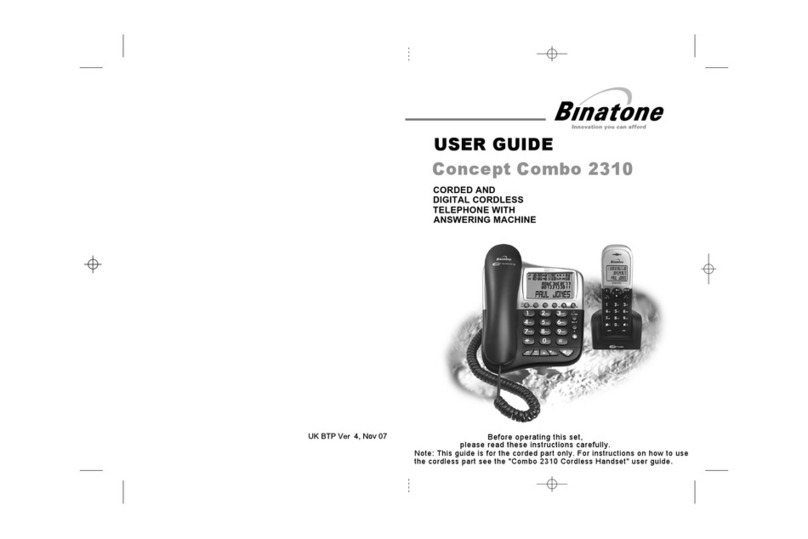
Binatone
Binatone CONCEPT COMBO 2310 user guide

Alcatel-Lucent
Alcatel-Lucent Alcatel 8 Series IPTouch 4068 instruction manual
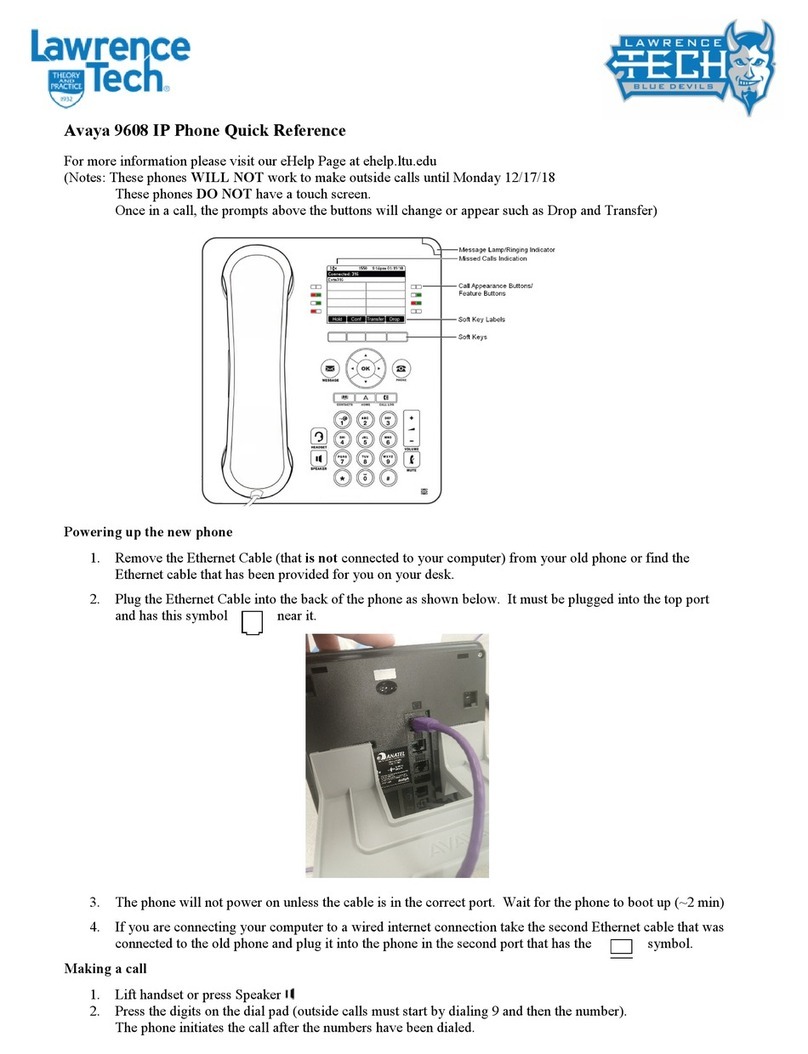
Avaya
Avaya IP Office 9608 quick reference
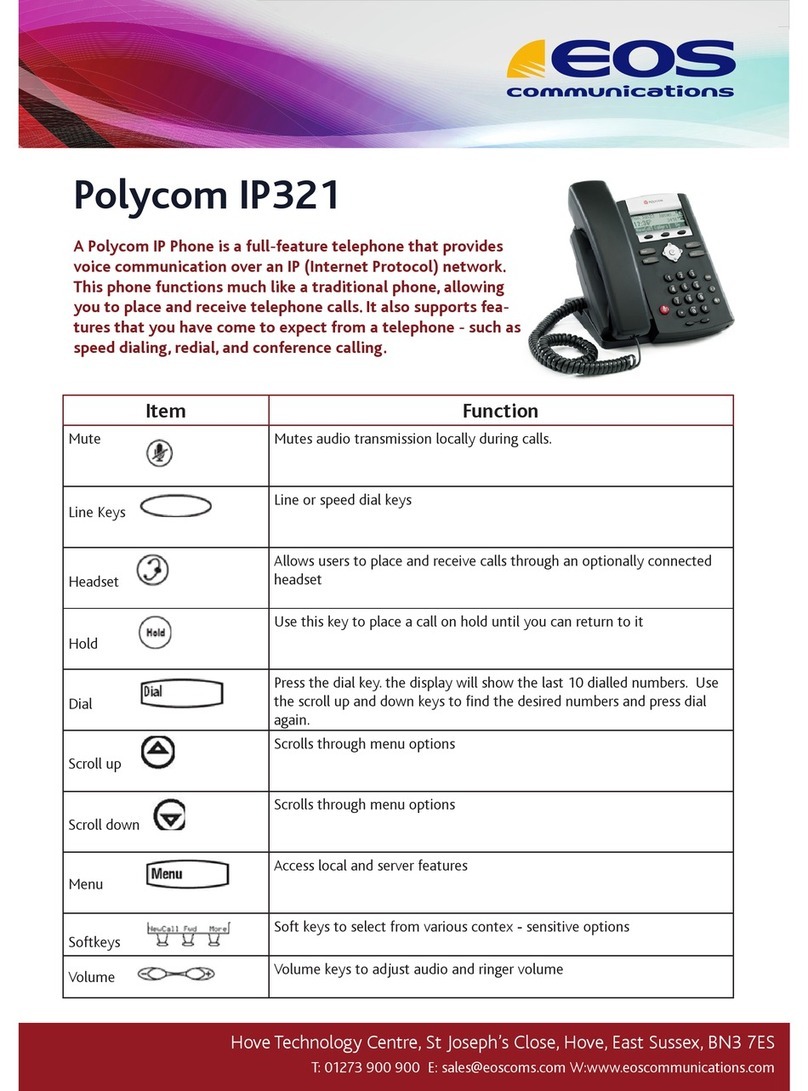
Polycom
Polycom SoundPoint IP 321 user guide
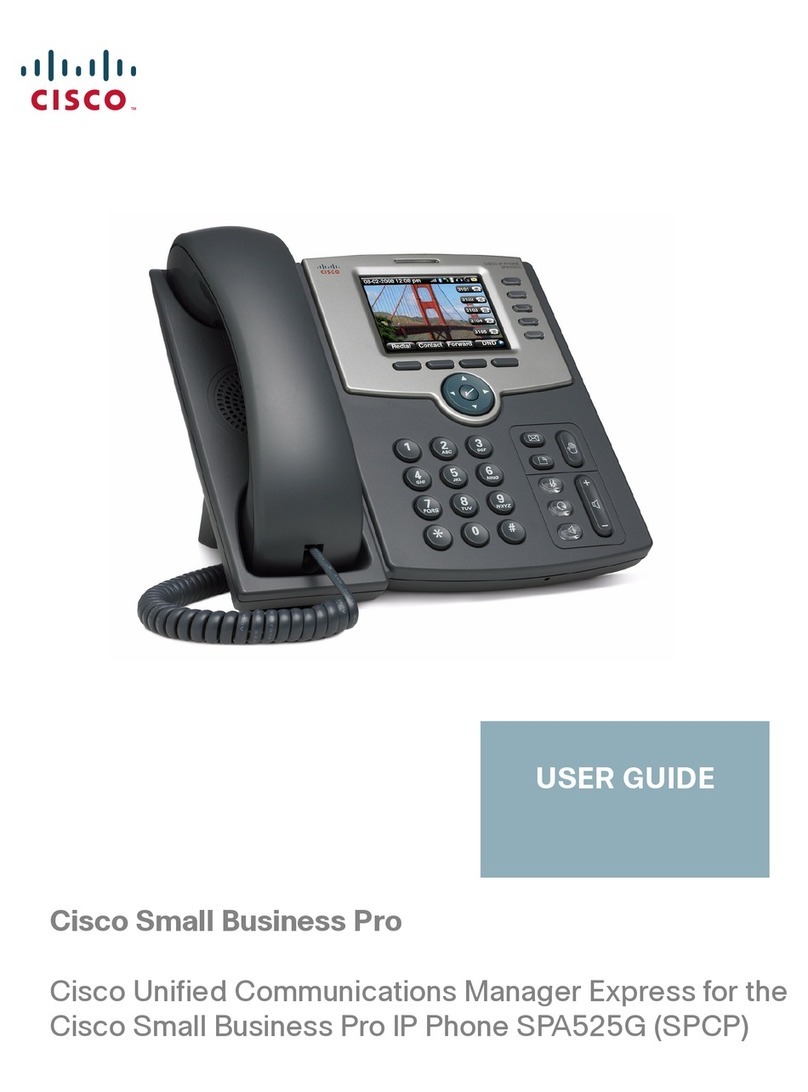
Cisco
Cisco SPA525G - Small Business Pro IP Phone VoIP user guide
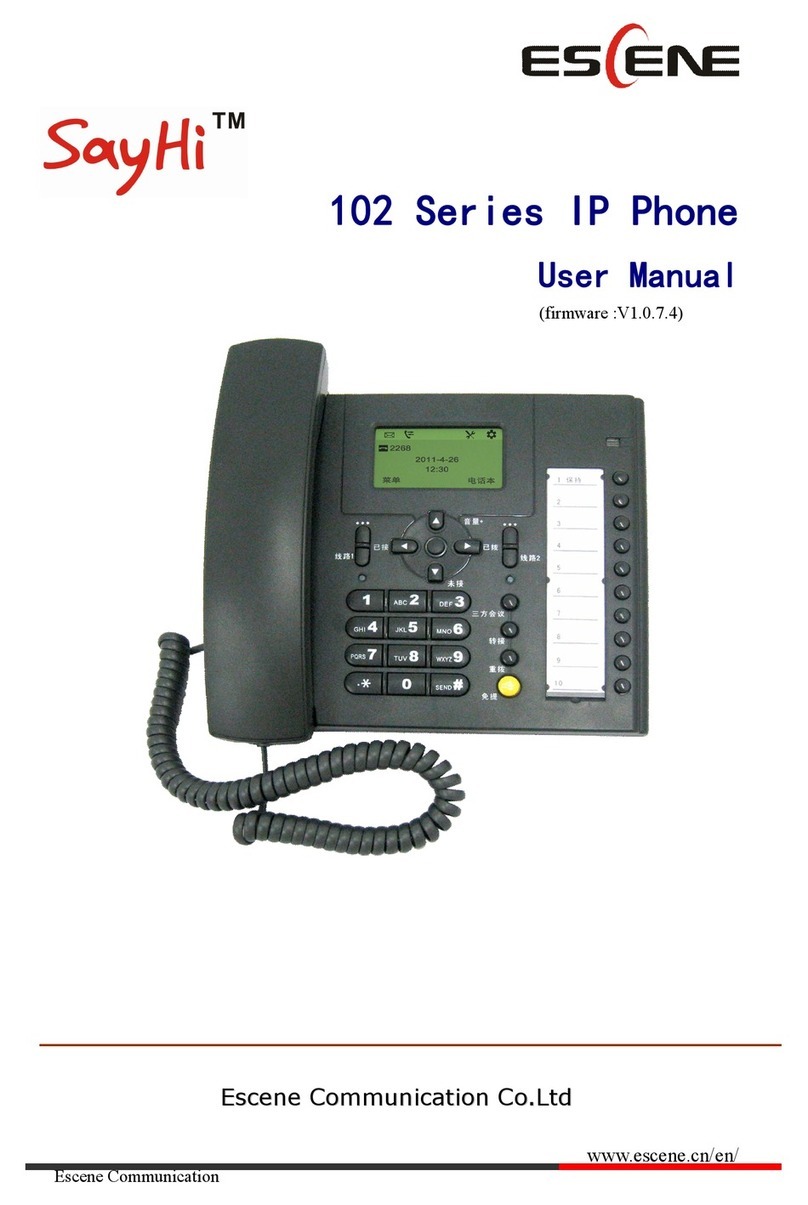
Escene
Escene 102 Series user manual
